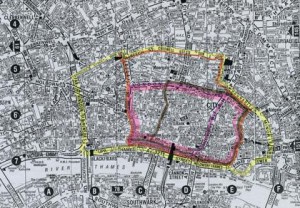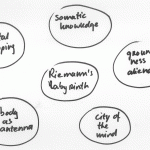The questions I voiced in my original research proposal circled around children’s play as a way of…
Riemann space and a philosophers way with words
Promised myself a post on the second lecture Annette Balkema gave, and here goes. Still on the subject of ‘how to think – how to do research’ we discussed chapter 14 of Deleuze’s ‘A Thousand Plateau’s’, lovingly nicknamed ‘ATP’.
In it Deleuze discusses smooth space and striated space. Again: very difficult to understand and follow his train of thought. Two of the six models he gives I sort of understood. One was the ‘technological model’ where striated space is woven fabric and smooth space is felted wool. Because I work with fabrics a lot, especially wool, and have knitted, croche-ed and felted it, this model clicked with me. The ‘maritime model’ gives the sand of the desert and the surface of the sea as smooth, both surfaces becoming striated when a grid of parallells and meridians is projected onto them. Also something I can connect with.
When I tried to grasp the mathematical model I ran into problems. I know who Riemann is and how to do a Riemann integral, and could even explain to you what differences there are between a Riemann space and an Euclidian space. But the way Deleuze references mathematics I do not understand.
Anyway, revisiting Riemann did give me an idea how to go about a ‘labyrinth that happens’. To explain I have to tell you about Riemann spaces first. Here goes: A Riemann space can be expressed in mathematical terms by a rather simple formula that sort of tells you to start at a given point and gives you directions about how to go to the next point. Going from point to point, in the way the formula describes, and making the intervals between the points smaller and smaller, you make up a surface. The Riemann surface is not flat but wavvy, like the desert or like the sea.
 So a Riemann space is made by applying a formula to the way you move around. This I can do with labyrinths, too! I can traverse a city, starting at a given point, and move around according to a ‘formula’ or a rule, like ‘ turn left when someone smiles at you, turn right when someone frowns’. Have to think about this a bit more, but it sounds exiting! I could use my new GPS toy to record my walk through the city labyrinth, so that I have a visual representation. Well, it’s an idea, anyway. Will let this simmer for a while. Riemann Labyrinths. [later: serendipity! I just checked on the artist who did the people-sundial work in Mexico City, turns out to be Francis Alys. I found work he made doing walks in London: seven walks, pretty cool]
So a Riemann space is made by applying a formula to the way you move around. This I can do with labyrinths, too! I can traverse a city, starting at a given point, and move around according to a ‘formula’ or a rule, like ‘ turn left when someone smiles at you, turn right when someone frowns’. Have to think about this a bit more, but it sounds exiting! I could use my new GPS toy to record my walk through the city labyrinth, so that I have a visual representation. Well, it’s an idea, anyway. Will let this simmer for a while. Riemann Labyrinths. [later: serendipity! I just checked on the artist who did the people-sundial work in Mexico City, turns out to be Francis Alys. I found work he made doing walks in London: seven walks, pretty cool]
Another thing popped up after Annettes lecture. Remember, I’m an engineer by training, and this was the first time I met a real-life philosopher talking about philosophy. What struck me – not immediately but when driving home last night – is that philosophers are really into words. This may not be a very original thought, and I have problems pinning it down, but I’ll try anyway: It seems to me that philosophers see words as entities that are in themselves real, charged, have existence, carry weight, have meaning.
I have always regarded words as being no more than a good – if imprecise – way of referring to things, better and easier than saying ‘that thing over there’ all the time. Like it’s much easier to talk about ‘that dog’ than it is talking about ‘that animal with the furry coat and curly tail”. For me, words in themselves have no meaning, like counting words have no meaning apart from the numerical value they represent. Meaningful, in an engineering way, are measurements, for example how big, small, hot, cold, heavvy, etc etc an object is.
It seems to me that philosophers think that finding the right words will reveal something to us about the nature of the thing the words refer to. Not very elegantly expressed, but can do no better for now. Will talk about this with Annette when next I see her.
I asked Annette about validating one’s research findings Popper-style, question got redirected to Henk Slager and next week’s class. So: to be continued.
| « It’s mine, all mine …. | <-- previous post | next post --> | The problem of organisation » |
|---|







